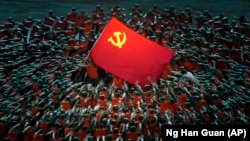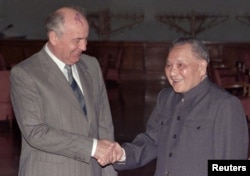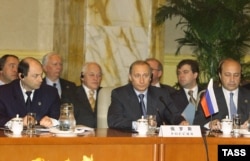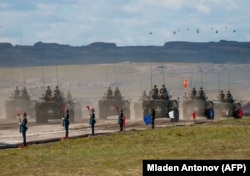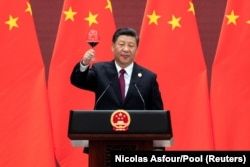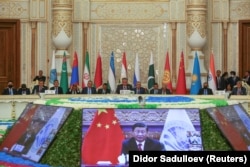For three days in May 1989, Soviet General Secretary Mikhail Gorbachev visited Beijing amid great fanfare.
It was the first visit by a Soviet leader to China since a border conflict in 1969 that sparked decades-long tensions between the two countries, and it would be the last.
Over the next two and a half years following Gorbachev’s landmark visit to China, Beijing’s and Moscow’s paths diverged.
The Soviet Union saw its status as a world power diminished as its leadership grappled with rising nationalism as well as economic stagnation and collapse that culminated in the country’s official dissolution on December 26, 1991.
In contrast, China was propelled on a path of steep economic growth that saw decades of growing living standards at home and expanding influence abroad leading to its current status as a global force.
Thirty years after the collapse of the Soviet Union, the legacy of that monumental shift is still being felt across Eurasia as it paved the way for China’s three-decade rise to influence throughout the supercontinent.
The Soviet Union’s dissolution and the creation of 15 new states was met with caution in Beijing, but the end of tensions with Moscow freed up Chinese resources and planning to focus outside its borders in a way that wasn’t previously possible.
This set China up to become a leading force in Central Asia, forge newfound political ties with Moscow, and eventually launch the globe-spanning Belt and Road Initiative (BRI), which opened the door for Chinese companies and reoriented much of the economic gravity of Eurasia.
“With the security threat posed by the Soviet Union gone, China was free to invest those resources elsewhere and eventually expand its influence to its West,” Haiyun Ma, an associate professor at Frostburg State University in Maryland, told RFE/RL. “This is a major achievement for Beijing. Chinese influence is basically everywhere today.”
The Soviet Union’s end also deeply impacted thinking at the top in Beijing. Avoiding a similar fate as its communist peer has been a fixation for Chinese policymakers and current leader, Xi Jinping, who called the U.S.S.R.'s dissolution “a profound lesson” in a 2013 speech.
'A Cautionary Tale'
Those lessons learned, according to Xi’s speech, are that Soviet leaders bent too far on their resolve and ideology, a point of view that many analysts say has fueled a crackdown on dissent at home and a desire to expand Chinese power globally.
Subscribe To Our New China Newsletter
It's impossible to tell the biggest stories shaping Eurasia without considering China’s resurgent influence.
China In Eurasia is a newsletter by correspondent Reid Standish in which he builds on local reporting from RFE/RL’s journalists to give you unique insights into Beijing’s ambitions. It's sent on the first and third Wednesdays of each month.
To subscribe, click here.
“For the Chinese Communist Party, the collapse of the Soviet Union is a cautionary tale,” Nadege Rolland, a senior fellow at the National Bureau of Asian Research, told RFE/RL. “There is a lot of anxiety behind Chinese policy. It’s a fear about losing power and a desire to maintain it at all costs.”
Initially, Chinese moves across Eurasia were not ambitious or high-level. Beijing was grappling with how to view its new neighbors, which were navigating economic hardships and a wave of political crises -- from a civil war in Tajikistan to fighting in Russia's North Caucasus.
The collapse of the Soviet Union, whose actions had helped fuel a rapprochement between Beijing and Washington during the 1970s, also prompted fears that China could be next as the United States and its allies reveled in the end of the Cold War and efforts to roll back communism.
With instability and uncertainty high in the states of the former Soviet Union, Beijing moved cautiously in the 1990s. China focused on its economic development at home and launched a major diplomatic campaign to improve ties with its East Asian neighbors and attract investment into the country.
While in Central Asia, China began to play an intricate role in the country’s post-Soviet shuttle trade as Beijing also looked to shore up its security fears and settle long-standing border disputes.
But Chinese involvement grew slowly in the region, in large part due to Beijing’s worries over how an insecure post-Soviet Russia would react.
In April 1996, the leaders of China, Russia, Kazakhstan, Kyrgyzstan, and Tajikistan met in Shanghai to sign an agreement to pull back military forces from the former Chinese-Soviet border and provide a mechanism to settle border issues with its newly independent neighbors.
The agreement resulted in the formation of the Shanghai Five, which would go on to become the Shanghai Cooperation Organization (SCO) in 2001 with the addition of Uzbekistan (and has since welcomed India and Pakistan as members).
“China never wanted to challenge Russian openly. That’s why Beijing penetrated the region economically first and then grew its influence elsewhere,” said Ma.
Over the following years, China cemented a broad strategy focused on not interfering in other countries’ affairs, building up economic cooperation, and boosting its reputation across the region.
As China’s rise throughout the 21st century began to shift its perception in Washington as a future competitor, Beijing put an even stronger emphasis on deepening ties across Eurasia, especially as an American military presence and a constellation of U.S. allies in East Asia put limits on Chinese strategy.
“The rise of China alerted it to the United States and others,” said Ma. “Expanding overland to the West was a much safer way than in the Pacific region where tensions could rise quickly.”
Marching West
Throughout the 2000s, Chinese strategists focused their attention toward Eurasia, which became a hub for new policies from an increasingly confident Beijing.
But as Daniel Markey, the author of China’s Western Horizon notes, it wasn’t immediately clear at the time that Beijing would rise to its current status across the former Soviet Union.
READ MORE: Special Section On The Fall Of The U.S.S.R.
“It wasn’t evident that China would be the one to benefit from the dissolution of the Soviet Union or would be in a position to extend its influence into Eurasia,” Markey told RFE/RL.
Beijing’s focus centered mostly on Central Asia, which Chinese policymakers began to see more and more as a strategic area vital to its own security located along Afghanistan and China’s western Xinjiang Province. The region is also rich in natural resources, which as the world’s largest consumer of oil and gas, China needed to fuel its domestic growth.
In 2010, Liu Yazhou, a general in the People’s Liberation Army, famously referred to Central Asia as a “rich piece of cake given to today’s Chinese people by heaven” that he said was a strategic soft spot for Beijing where Western pressure would have “a more far-reaching influence” than in the Pacific.
Around the same time, a series of shifts continued to alter Beijing’s position in the world.
China managed to weather the 2008 global financial crisis better than most countries, but emerged from it facing overcapacity issues for many of its industries and needed access to new markets. Moreover, as China overtook Japan in 2010 as the world’s second-largest economy, many countries across Eurasia were eager to attract investment and had limited access from the West or Russia.
“China wasn’t always seen as an attractive investor,” said Markey. “It wasn’t until the financial crisis that many countries really opened up more to China, in part due to desperation and a need for investment.”
In 2012, Wang Jisi, an influential scholar and former dean of the School of International Studies at Peking University, outlined a strategy for a massive economic and diplomatic push westwards to build influence in Eurasia. Dubbed “March West,” the strategy was a response to American rebalancing toward East Asia and many of its ideas formed the foundation for the BRI, Xi’s flagship foreign policy project that was unveiled in Kazakhstan in 2013.
The global BRI has since launched projects across Latin America, Africa, and Eurasia worth hundreds of billions of dollars and allowed Beijing to expand its influence and create new opportunities for its companies as it invests in strategic locations like Pakistan’s Gwadar Port, rail links across Central Asia, and Iran’s vast but troubled oil sector.
“In the minds of many Chinese policymakers, China has revived its historic and traditional role across Central Asia and other parts of Eurasia,” said Frostburg State University’s Ma. “In 30 years, it has changed from being an area of mostly Russian influence.”
The New Eurasia
While Gorbachev’s visit to China in 1989 wasn’t the game changer that some Soviet policymakers were hoping for, that vision for stronger Beijing-Moscow ties has been realized under Xi and Russian President Vladimir Putin.
Russia has watched China’s rise with apprehension and Moscow also has its own plans for the region under the Eurasian Union. Despite that, the two sides have still managed to form a closer relationship in recent years, with Putin remarking that ties were at their highest-level ever in July.
“The demise of the Soviet Union opened the door for more friendly relations with Russia,” said the National Bureau of Asian Research’s Rolland. “It’s kind of mesmerizing to observe how rapidly things changed.”
While Beijing and Moscow do not see eye to eye on many issues, they have avoided letting frictions bubble over and largely been driven together by a shared animosity toward the United States. Both China and Russia have shown an increased willingness to tackle international issues together and have begun to conduct military exercises together.
Many analysts are cautious, however, about how sustainable that dynamic will be, especially as Beijing continues to expand its security presence across Central Asia and grow its economic influence across a part of the world that the Kremlin views as within its “sphere of influence.”
“Beijing plays the long game and has so far been very smart in alleviating Moscow’s anxieties,” Rolland said. “But they can read the writing on the wall and ultimately see Russia as a declining power.”




